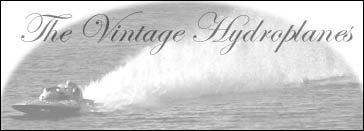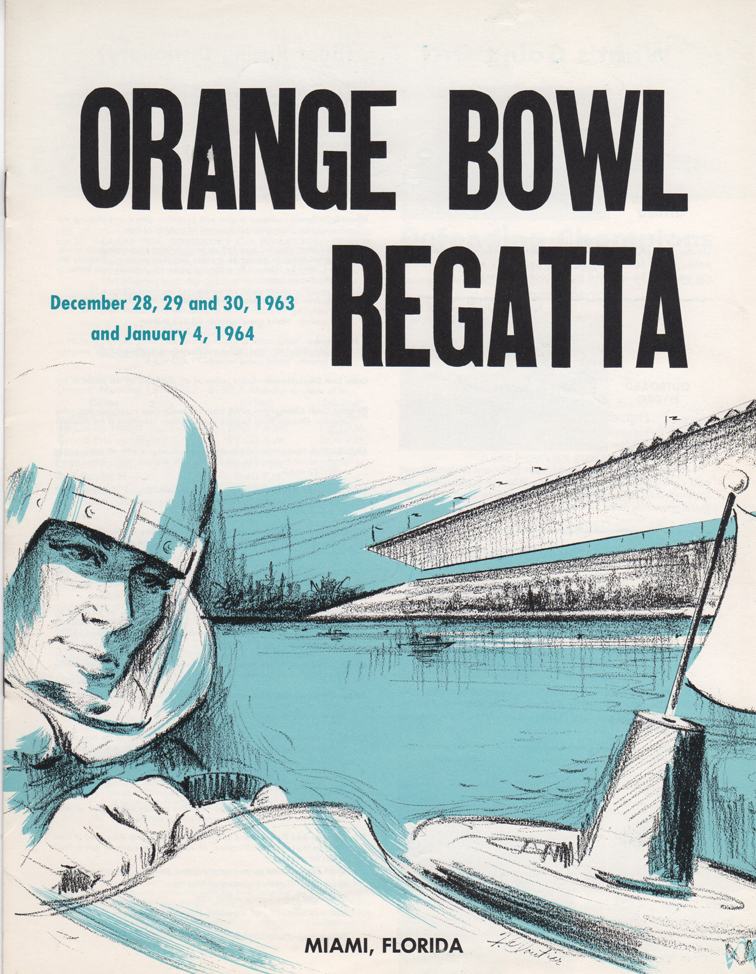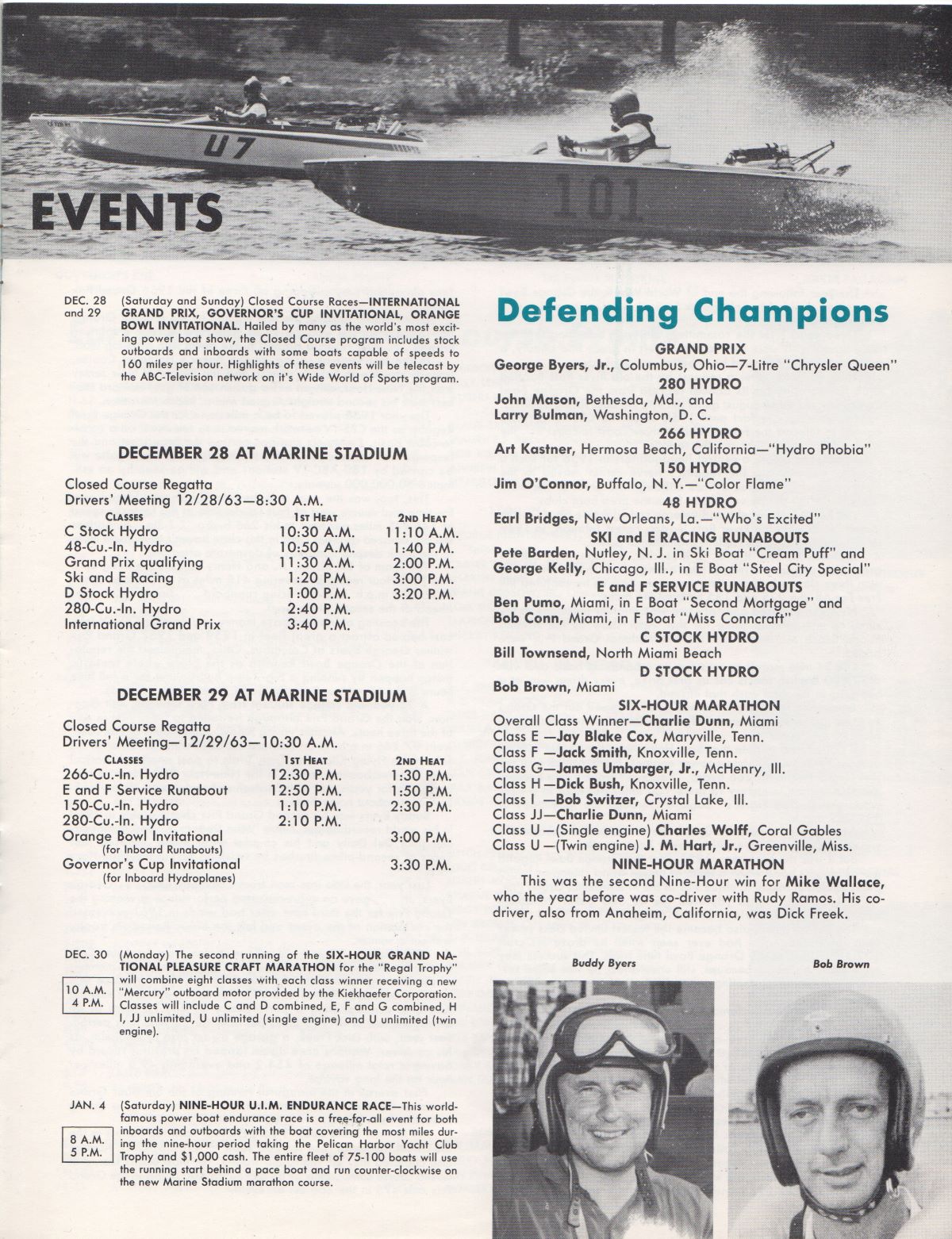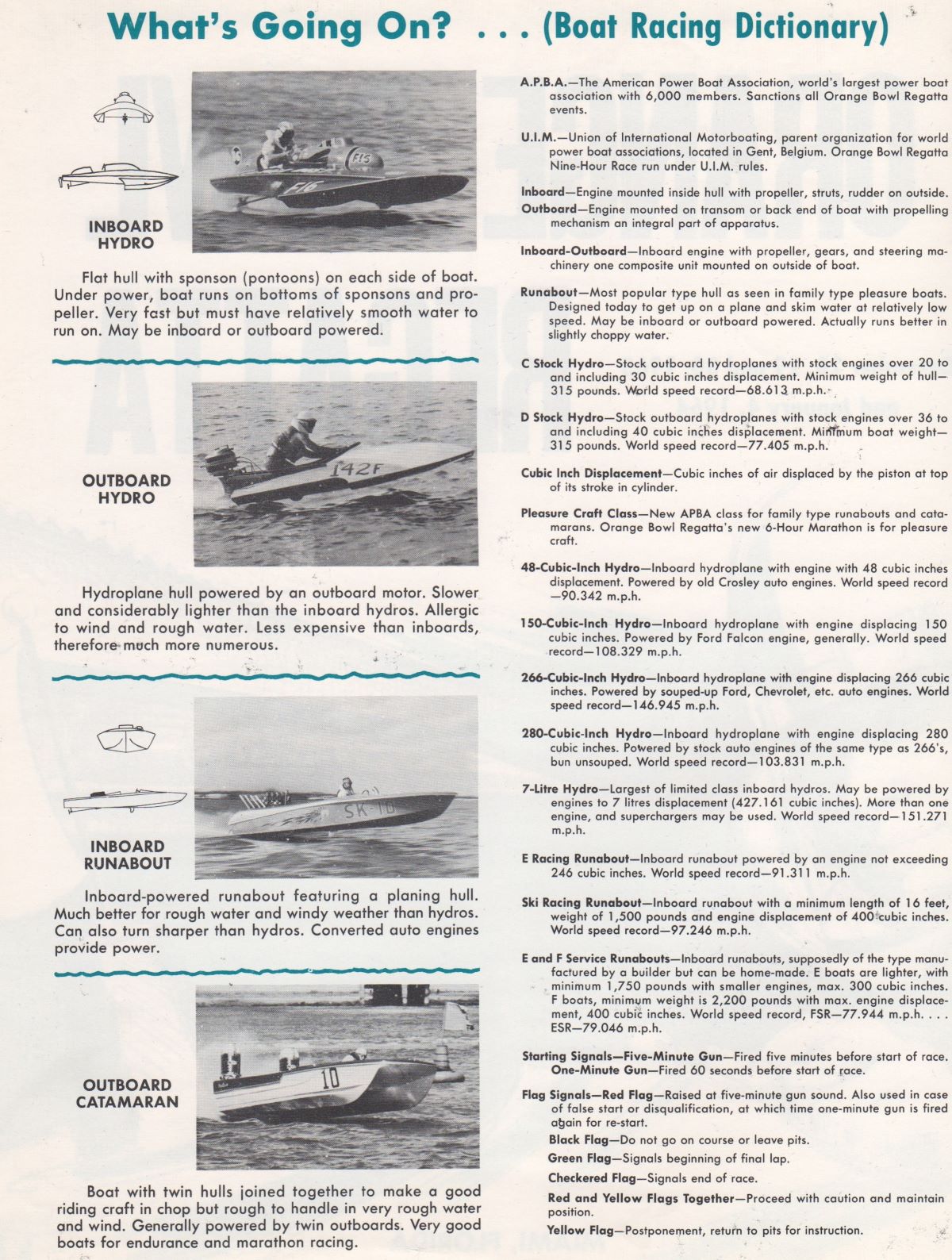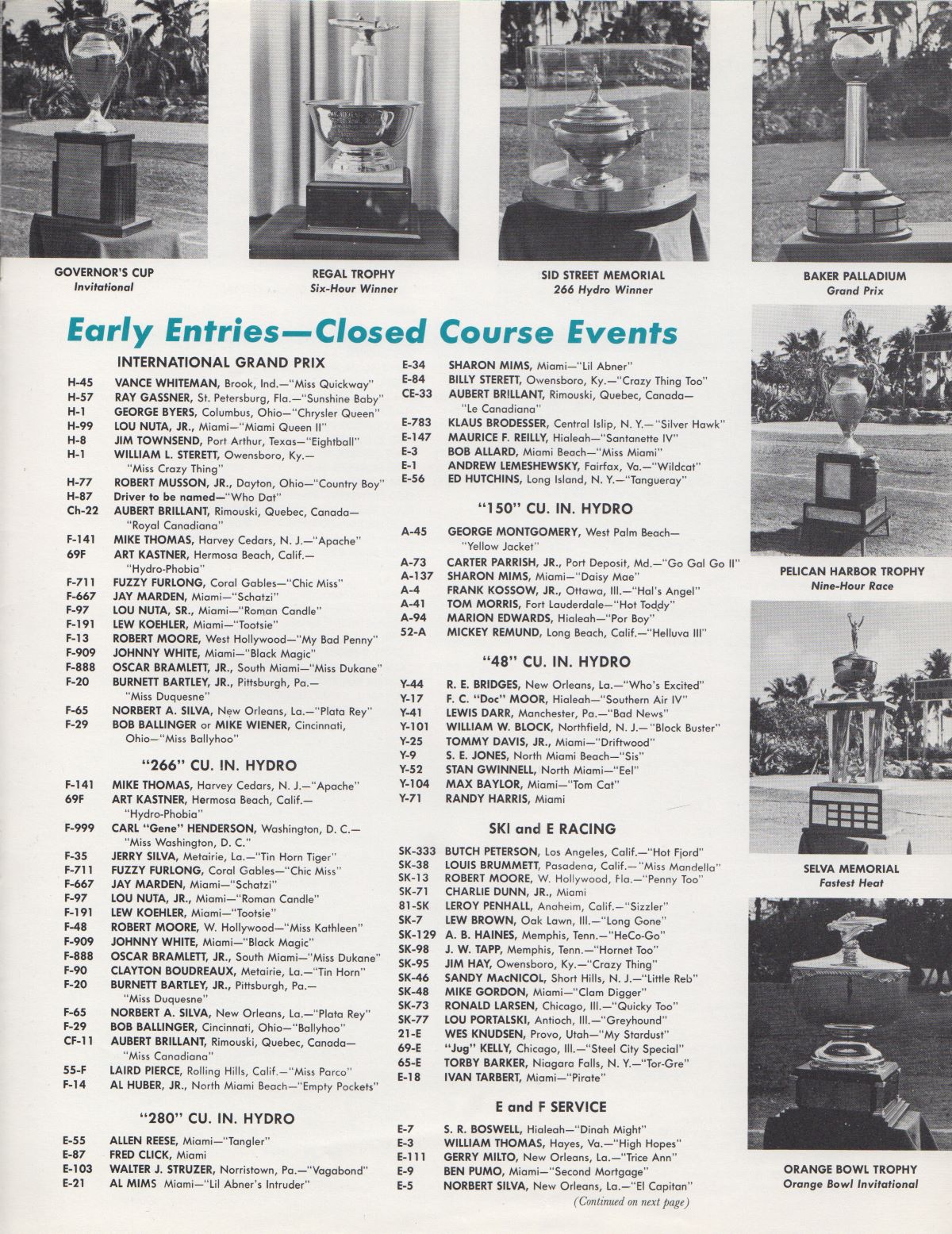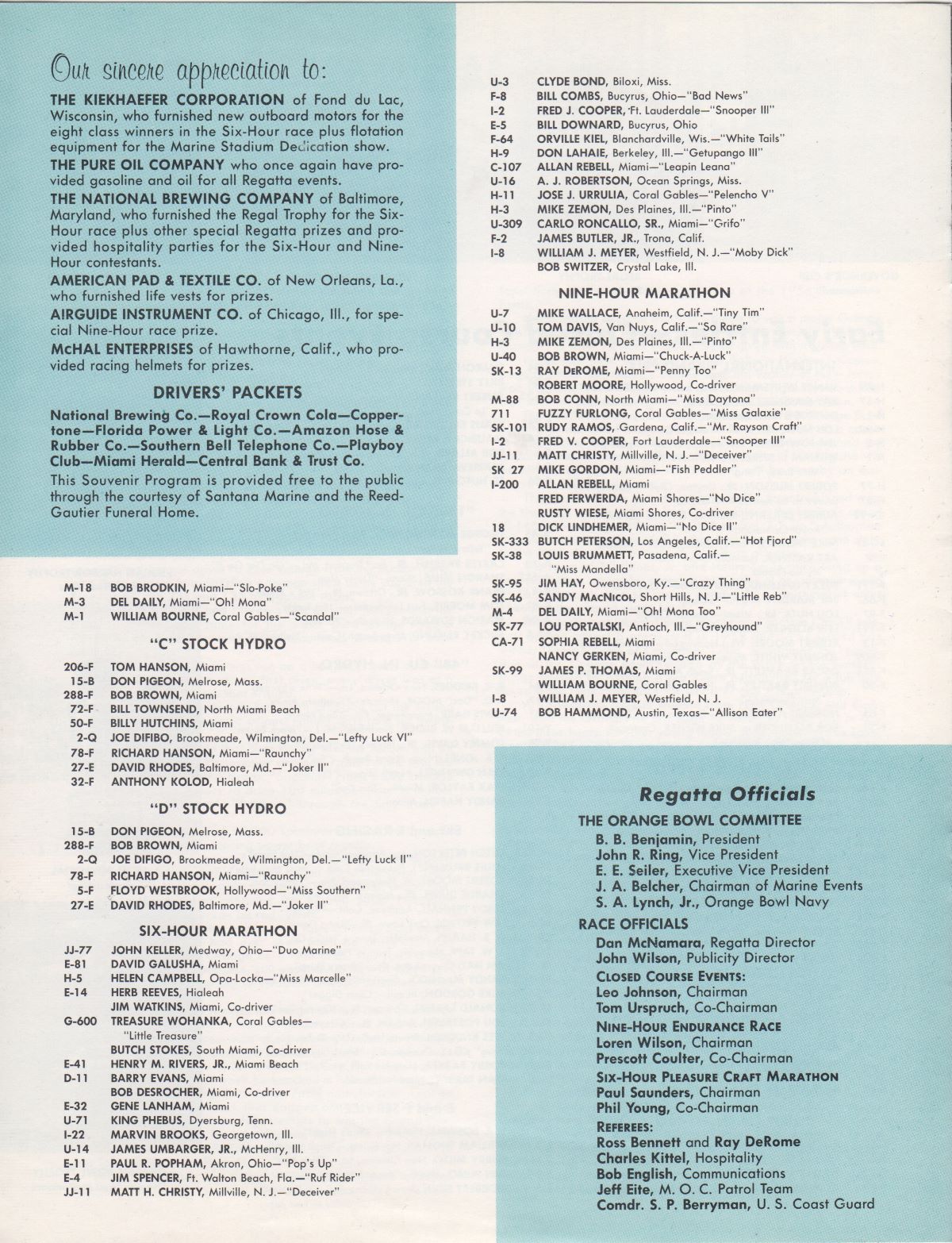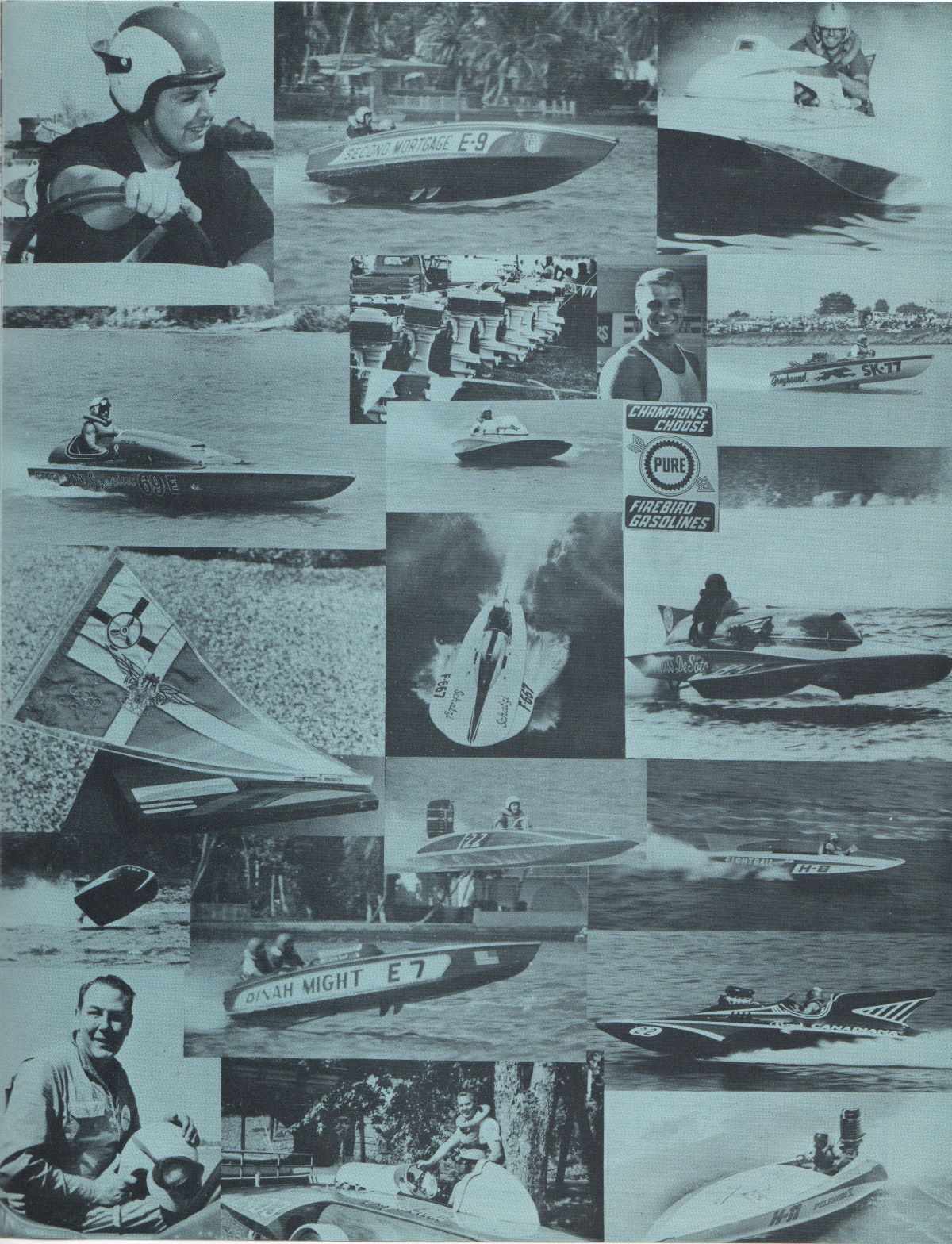The year following the end of World War II, The Orange Bowl
Committee decided to enlarge its festival, electing to add a sail-
boat regatta.
Three years later the committee, although admitting that the
wind-driven craft were akin to the angels in grace and beauty, a
power boat regatta would be a better crowd pleaser.
Thus, in 1949, after a request by the old River Rats Boating
Club for a trophy for its annual regatta from The Orange Bowl
Committee, did those August Gents get into the boat racing business.
For years....in fact until 1958 when the CBS-TV network agreed to telecast
the famed marine show coast-yo-coast...the
various local yacht clubs ran the regatta.
In order to create a central headquarters in 1958 for such a
complex undertaking, the regatta's nerve center moved to the
Orange Bowl Committee offices although the brunt of the work
was still carried out by volunteers from the area boat clubs.
The late Bill Mansfield and veteran racing figure Sam Griffith
joined forces with the River Rats leader, Forest Johnson, in 1949
to give the regatta on excellent promotional punch.
That was the year that D.C. Kiesocker. the man the
greatest hydroplane driver to ever emerge from the Miami scene,
won three classes in g dazzling one-man show as he captured the
Free-For.All, the 225 and 135 hydroplane races.
Nineteen hundred and fifty-two was another milestone in the
climb to international fame for the water show as the Around
Miami Beach Marathon and the International Grand Prix were
The 24.mile marathon was run on a handicap basis and with
a $2,200 English sports car first prize, every driver at a
handicap in the mad dash that ensued.
Since then the Beach race has been dropped but the Grand
Prix has grown into 'the world's finest limited Class race for hydro-
planes.
It's of interest to note that Sam Holten won the AMBM with an
outboard with two 7-1/2 horsepower engines. Frank Foulke won the
first Grand Prix in his 266 hydro, Sagana. Frank's wife became
the first woman in history to drive 100 miles per hour in a boat
when she steered Frank Sagana through the time traps at 111.289 m.p.h.
An estimated crowd of 50,000 spectators proved that people
will come out to see an exciting power boot regatta.
But it was the next year, 1953, that the Orange Bowl Regatta
got its biggest boost when a team of Italian world champion hydro
pilots landed in Miami to make war in the International Grand Prix.
Italy's Mario Verga captured the $7,500 Baker Palladium
trophy for the Grand Prix in his red "Laura."
The daring Italian also became the fastest limited class power
boat driver the world had ever seen when he drove his craft
132.185 m.p.h. in the Orange Bowl time trials. This success may
have led to his doom because, still unsatisfied, he was killed sev-
eral months later attempting to establish a world unlimited hydro
mark.
The first of the now famous International Nine-Hour Endurance
Races was run in 1954 . , . the brainchild of driver Sam Griffith.
It was won by the three-man gang of Ray DeRome, Howard
Abbey, and Howard Hibbert in a boat Abbey built. Kiesaeker won
the Grand Prix and one of the original Italians from the year be-
fore, Ezio Selva, lost out when he knocked a hole in his boat,
Selva, a greying, dignified Italian cable manufacturer kept on
trying to evade the bad luck that dogged him until the 1957 Re-
gatta. After three unsuccessful attempts to win the Grand Prix,
Selva was killed when his boat flipped that year, Ironically, he
had clinched the Baker Palladium Trophy. He is the only man to
ever lose his life in the Regatta,
Henry Lauterbach, the skilled Virginian. come back to defeat
all comers in the 1955 and 1956 Grand Prixs. He stunned the | fans along shore by sweeping all three of the 1956 Grand Prix
heats.
Helen Martin became the first woman to win 0 major Orange
Bowl race when she won the 1956 Nine-Hour Race in a Johnson
Prowler.... after Howard Hibbert broke down with a six-lap lead.
In the last of year of racing on the Baker's Haulover Course,
tragedy struck with Selva's demise and Jim Venner Of New Jersey
won the Nine-Hour with an extra gallon can gas. Howard Hilbert
took his second straight Around Miami Beach Marathon.
The year 1958 proved to be a milestone for the Orange Bowl
Regatta as the CBS-TV network moved in to televise it on a coast-.
to-coast basis. Eighty-six stations carried the broadcast and the
response was tremendous. Today the highlights of the Regatta will
be carried by 80 ABC-TV stations and will be seen by an esti-
mated 30,000,000 viewers.
This, too, was the year that the late Sid Street whizzed over
the time trial course west of Fort Lauderdale at the fantastic speed
of 146.945 miles per hour in his 266 hydro Z-Z-Zip. Authorities
still are amazed as other craft in this class haven't even come close
to the mark despite hundreds of desperate attempts.
The team of Bill Ritner, Jr. and Henry Lauterbach hung up a
new Nine-Hour record by covering 418 miles at on average speed
of 46.378 m.p.h. in a ski racing runabout . . finishing 54 miles
ahead of the second place boat.
The boosting of inboard prize money and another CBS-TV tele
cast helped attract a great fleet in 1959 and 1957 Grand Prix
winner George Byers of Columbus, Ohio, maintained the reputa-
tion of the Orange Bowl Regatta as the place where fantastic
things happen by running a big 7 -litre hydroplane for nine
hours in the Nine-Hour Race for world 7- and 9-hour records.
A 23-year old college student from New Orleans, Milt Gagnon
won the Grand Prix although he failed to finish first in any
of the three heats. Another young fellow, John Moulis of Fox Lake,
went 97.246 m.p.h. in an inboard ski boat with his father at his
side in the Flying Kilometer Time Trials to post another historical
mark in powerboating annuls. In the Nine-Hour Race, Howard Hibbert,
who for years met with frustrating breakdowns, drove his F-Service
runabout home first.
Buddy Byers won his Grand Prix championship in
in world record holder 7-litre Miss DeSoto V and Miami
line pilot Del Daily and his co-pilot wife, Mona eclipsed four
years of second-place finishes by finishing first in the Nine-Hour race.
Last year, the little iron man from Columbus, Ohio . , . George
Byers, Jr. . . . gave an unprecedented performance in winning the
Grand Prix for the third time after bad winds in 1961 prevented
the completion of the event and left the Baker Palladium trophy
without a winner.
Mike Wallace, 21-year old college Student from Anaheim. Cali-
fornia, for the second consecutive year, participated as a member
of the winning team in this famous event. In 961 , Wallace was
co-driver with Rudy Ramos as the Californians toppled the existing
record in accomplishing a performance of 432.18 miles at an
average speed of 47.795 miles per hour for the nine-hour period.
Last year, with Dick Freek, a garage owner also of Anaheim, as
his co-driver, Wallace once again topped his previous record by
having a total mileage of 454.2 and averaging 49.8 miles per
hour for the long voyage,
First overall in the inaugural running of the Six-Hour Grand
National Pleasure Craft Marathon was Charlie Dunn, a young
executive from Miami.
Art Kastner in his sleek Hydro-Phobia took top honors in the
Sid Street Memorial race for 266 cubic inch hydroplanes. Kastner
also captured the "Bill Mansfield Trophy" for most points scored in
closed course competition as he picked up 400 points in the Grand
Prix and 495 in the 266 cu. in. event. |
